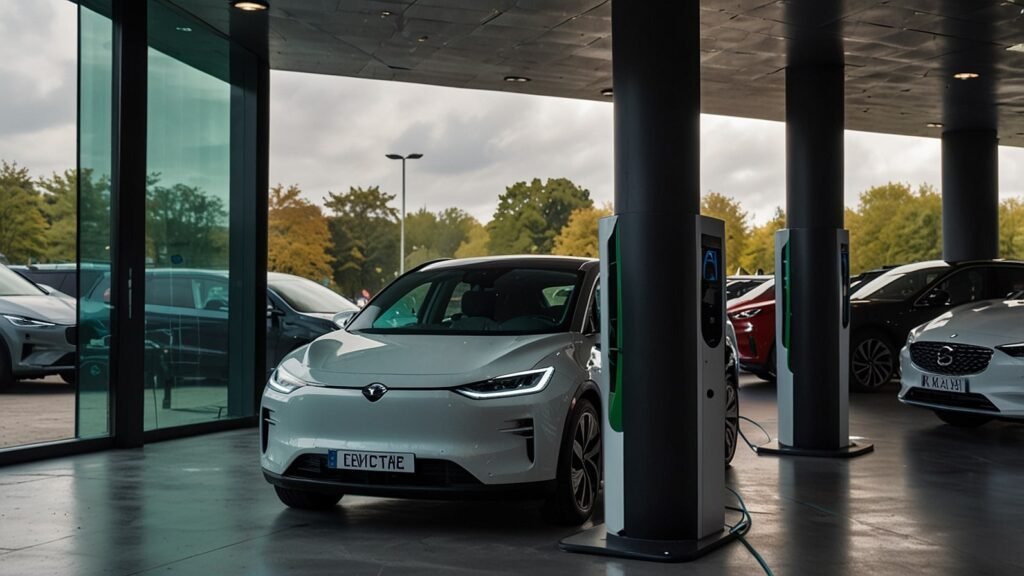
Hey there, car fans! Whether you are a petrol head and enjoy the sound of an engine or a person who has his sights on an electric vehicle as the next ride, the UK car market in 2025 is a craze to observe.
This year is narrating an interesting story in terms of new car sales, with some brands performing remarkably, others faltering and electric vehicles (EVs) taking the limelight. We will enter the trends, the winners, the losers and the cause of all the EV boom through the eyes of someone who is as excited about cars as you are.
The Oversight: A Mixed Bag for New Car Sales
The UK automobile market is somewhat of a zigzag trip in 2025. All in all, the new car registrations will increase marginally by approximately 2 per cent to approximately 1.98 million vehicles. That is good, but it is still 14 per cent less than before the pandemic, and thus, we are not exactly in the glory days.
June was a peak – it’s been the best since 2019, with 191,316 cars registered, which is 6.7 per cent higher than the previous year. But July was not without incident, and it declined by 5% to 140,154 units, and August also declined by 2% to 82908. It is a rollercoaster, propelled by supply chain hiccups, economic jitters and the great push towards greener vehicles.
The burden is being taken by the fleet sales, which comprised 60 per cent of the market in June and increased by 8.5 per cent. The case is more wary by the private buyers with the uptake increasing by 5.9 per cent in June and insignificantly 0.7 per cent in August. It is also obvious how the industry is putting businesses on its toes to ensure that things keep rolling, but ordinary drivers like us are also taking some time before they make the commitment.
Electric Cars: The Showman of the Show
EVs are buzzing, if that is one component in the market that is. Battery electric vehicles (BEV) are in a frenzy, as they will sell up to 440,000 by 2025, as compared to 381,970 in 2024. It is a 4.4 per cent increase, placing EVs at 24 per cent of the new car sales.
June was an excellent month, as BEVs accounted for 24.8% of registrations, and August achieved an all-time high of 26.5% market share. Today, EVs occupy 21.9 per cent of the market, but the point is the following: even if it is not enough to meet the goal of 28 per cent of Zero Emission Vehicle (ZEV) set by the government.
What’s fueling this growth? First, the current number of EV models has never been higher–30 per cent more than last year, with smaller, less expensive models making it to the showrooms. Emerging VAT on cars has been tempting new buyers with new grants of PS37,500 on EVs with a price below PS37,000.
Also, making payments is becoming more convenient, and Greater London has 22211 public charge points and rapid chargers, representing 45% of 45% since 2023. Such models as the revamped Skoda Enyaq and Audi A6 e-tron, with a range of about 400 miles, are eliminating range anxiety. And not least business benefits- with the current Benefit in Kind tax rates going down to low, fleets are going electric and saving drivers up to 40% on salary sacrifice plans.
But it’s not all rosy. The demand for the privates is slow, and the high initial price of EVs of an average PS49,790 versus PS34,225 of petrol models is a detrimental effect. The pressure of the ZEV mandate is real, and the manufacturers can be fined if they fail to achieve targets despite the rules giving some flexibility.
Winners: Who is Leading the Pack?
There are certain brands that are performing smashingly in 2025. First in line is BYD, a Chinese EV powerhouse that experienced an astronomical 550 per cent sales explosion in January, with 1,614 units sold, and 2,498 vehicles sold in June alone.
Their models are technology filled and priced at affordable costs. Another great winner by Ford, its EV sales will increase four times in the first half of 2025, becoming the fastest trending mainstream brand. The Tesla Model Y is the number 1 selling EV in the UK, and it is not surprising since it sold one million in the world last year.
Polestar, owned by Geely, was also off to a good start with sales increasing 216 per cent in January to 756 units. Jeep is also doing fine with its 87.5 per cent increase, and Lexus also improved 54.1 per cent and has reached 1,622 sales. These brands are either surfing the EV wave or niching, which proves that the risks and positioning decisions can pay off.
Losers: Struggling to Keep Up
It is not that everybody is having a good year. Market changes are giving some brands a hit. Alpine, smart, Ineos and Maserati niche players experienced a decline in sales by at least half in January. Citroen dropped down 46.3% to 1,256 units, Subaru dropped down 41.5% to 113, Jaguar dropped down 41.2% to 783, and Honda dropped down 32.6% to 1,624.
Even Ford, though its EV sales were successful, experienced a total sales decline of 31.6 per cent at the beginning of the year, indicating the difficulty of finding a balance between traditional and EV.
Even petrol and diesel automobiles are losing their ground. In July, petrol registrations fell by 14.7 per cent and diesel by 7.9 per cent, and buyers moved to electrified choices. Hybrids are also not doing much better, as it has declined by 13.9 per cent in August. The writing is on the wall: internal combustion engines are dying, with the ZEV rule forcing the adoption of cleaner technology.
What’s Driving the Trends?
So, what’s behind all this? The ZEV mandate is a significant driver that pushes manufacturers to focus on EVs under the threat of penalties. But it’s not just policy. Consumers are getting more receptive to EVs as prices are nearing petrol cars- a fifth of the BEVs are now cheaper than an average fossil-fuel car.
The infrastructure is also being enhanced, and the long journeys will not be so intimidating with fast chargers. Nevertheless, issues such as patchy rural charging and expensive EVs are deterring individual customers.
The industry is also struggling with international pressures. The imports of cheap Chinese goods are also spilling into things, and the tariffs of Brexit do not favour the manufacturers in the UK.
There are also concerns of job losses in case the transition is not handled with caution, especially when the factories are closed, and in the case of the Stellantis Luton plant. The EV push is also driving innovation, however, new battery technology, more gigafactories, and even hydrogen vans.
Looking Ahead
The new number plates in September could see the market boost in 2025, with the number of registrations usually going up to one out of every seven. The industry is crying out to get more support, such as tax breaks, to attract private buyers into the industry.
Provided that the government can combine the ZEV requirement with more favourable incentives and continue to develop charging infrastructure, EVs may reach that 28% mark even earlier than we may imagine.
To date, we have a car market in the UK that is a two-worlds story as EVs are galloping and traditional cars and certain brands are lagging behind.
It could be the slick Tesla you are longing to play with, or it could be your reliable petrol hatch, the trends of the 2025 reveal the electric in the future, and it is not that far away. What’s your take? Ready to power in, or waiting? Drop a comment and let’s chat!

